The Truth is far more powerful than any weapon of mass destruction. -GandhiLast time, I spoke to you about how tides work on Earth.
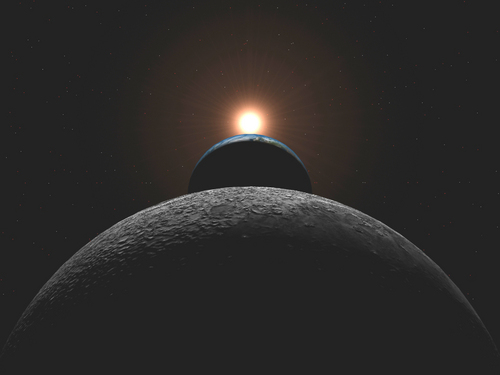
In a nutshell, a nearby massive body (like the Moon or the Sun) pulls on the Earth's center due to its gravity. But the portion of the Earth that's closest to that massive body gets pulled with a slightly greater force, while the portion that's farthest gets pulled with a slightly smaller force. This differential force, known as a tidal force, causes objects to be stretched out, and causes our oceans to bulge at the points nearest and farthest from the Moon, where the tidal forces are greatest.
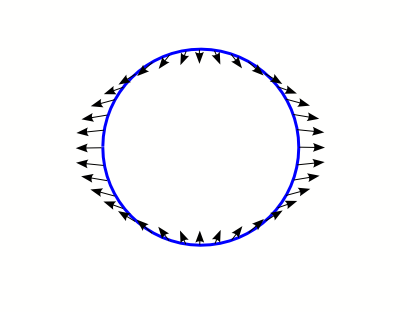
But what about more extreme cases? All you need for tides to be more extreme is to have three things in place: the object causing the tides needs to be massive, you need to be close to it, and you yourself need to be long. Let's start in our own Solar System, looking at our most massive planet, Jupiter. The nearest large object to Jupiter is its innermost moon, Io. Let's take a look at Io.
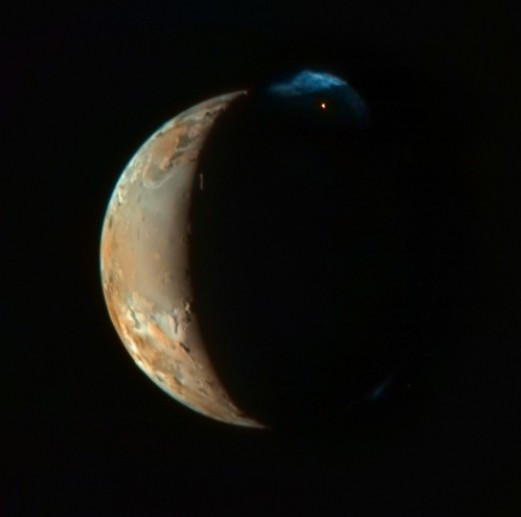
This was Io when New Horizons passed it just three years ago. Do you know what that bright spot on the unlit side is? That's a volcano! But Io is even smaller than Earth's Moon, which has a cooled core and is volcanically dead, and it's even farther from the Sun. Do you know where it gets the energy to have active volcanoes on it? Tidal heating from Jupiter.
But are these tidal forces ever strong enough to not only heat things up, but to completely tear objects apart? Let me introduce you to an old friend of mine from back when I was in high school.
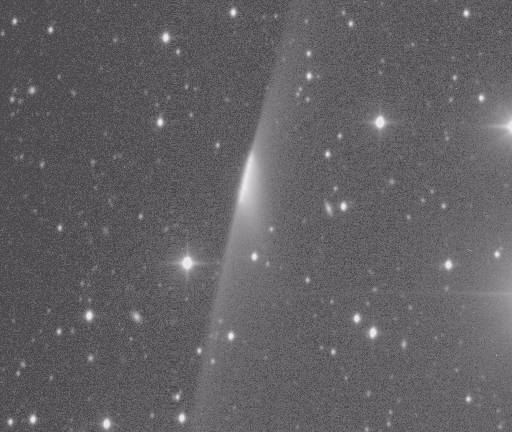
Say hello to Comet Shoemaker-Levy 9, as imaged in 1993 (shortly after its discovery). Shoemaker-Levy 9 was extraordinarily interesting, because shortly after its discovery, they realized it was headed right towards Jupiter. And when I say "right towards", this is what I mean.
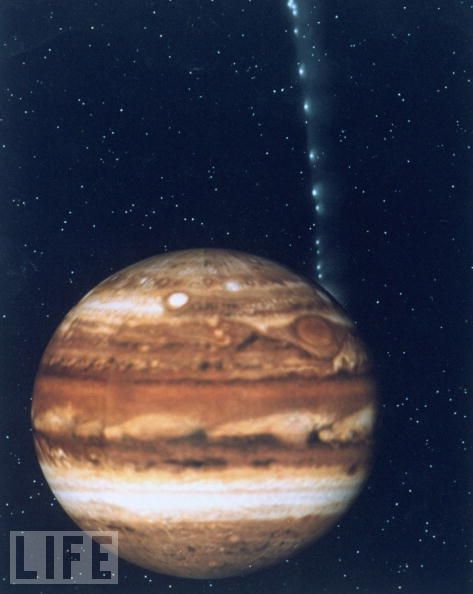
That's right, Shoemaker-Levy 9 became the first comet we ever observed directly to collide with another planet. But this image above is not a time-lapse photo! Instead, what we observed was that as the comet approached Jupiter, the tidal forces tore it apart, and stretched it out into a long, straight series of fragments. Take a look at what we saw when we pointed the Hubble Space Telescope at it back in 1994, shortly before the collision.
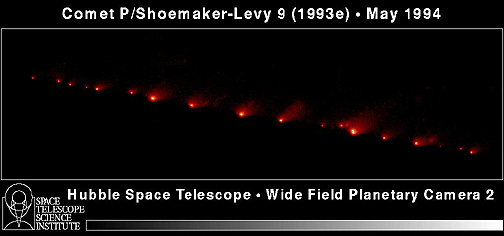
Amazing, that even in our Solar System, objects can be completely torn apart by tides!
But why stop there? We can go more massive, closer, and experience the greatest tidal forces in the Universe by approaching a black hole. After all, a black hole is a mass that's anywhere from a fraction of the mass of our Sun to over a billion times the mass of our Sun. What if you wanted to push the limits, and fly towards a black hole with the mass of our Sun?
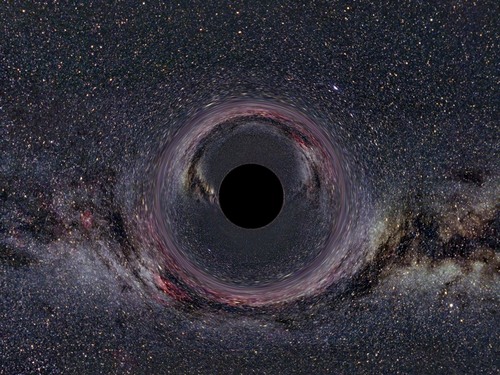
Oh yeah, space would look funny for a while, due to the distortion. But at some point, you'd really start to physically feel it! Just like the Earth gets thinner and stretched more, so will you. And it will be more and more severe the closer you get!
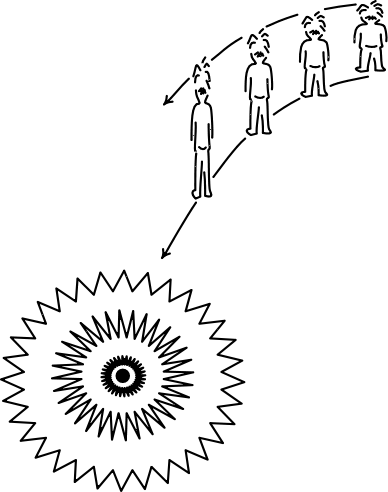
So what happens to you as you get closer and closer to the center of this black hole? Well, in order (and the whole process -- from the first item on the list until the last -- takes under a minute):
- your extremities (head, arms, legs) are torn from your torso,
- the individual muscles, tendons, ligaments, etc., are ripped apart from your body,
- your individual cells are torn apart from one another,
- the organelles inside each cell are ripped apart, destroying the cells themselves,
- the individual molecules from your body are ripped apart into atoms,
- the tidal forces tear your atoms apart into nuclei and electrons, and finally
- the individual nuclei are ripped apart into, eventually, quarks and gluons.
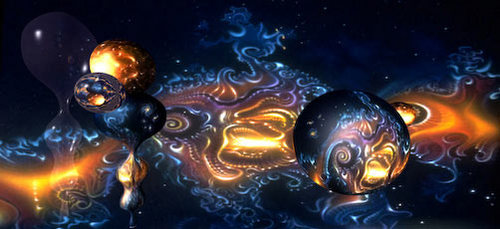
And a fun fact for you? At the event horizon of a black hole (as opposed to falling into the singularity, as above), the tidal forces are greatest for the smallest masses of black holes. In fact, if you went up to the center of our galaxy and went right up to the event horizon of our supermassive black hole, Sagittarius A*, weighing in at around 3 million Suns, the tidal forces on you would be less than the force of Earth's gravity is right now! This is because the event horizon for a more massive black hole is so much farther away than for a less massive one; it turns out that distance is more important than mass alone.
So if you want to destroy something with tides, just send it as close as possible to as massive an object as possible.

And keep this in mind if you've got dreams of traveling through a wormhole: you've got to survive the tides!

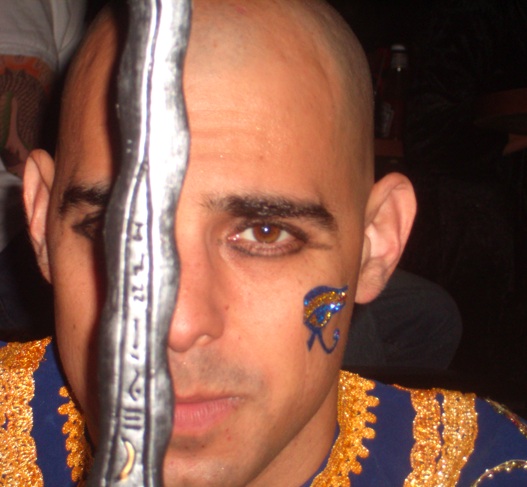



Comments
Isn't Io slightly larger than Earth's Moon?
http://en.wikipedia.org/wiki/Io_%28moon%29#Structure
Posted by: Jack | February 26, 2010 1:04 PM
My mistake; you're right! Io and the Moon are roughly the same size. That's a nice catch, although it doesn't change the fact that if it weren't for Jupiter's incredibly large tidal forces, Io would be as volcanically dead as the Moon is.
Posted by: Ethan Siegel | February 26, 2010 2:04 PM
You missed a prime opportunity to use perhaps one of the best words in the English language: Spaghettification! http://bit.ly/bBcHgd
Posted by: brand0con | February 26, 2010 3:39 PM
Is the next post in this series going to talk about Roche limits?
Posted by: Blaise Pascal | February 26, 2010 4:23 PM
Blaise,
That would be fun, but on Monday, I'm going to return to my "The Greatest Story Ever Told" series, and start talking about baryogenesis.
(If you wanted a preview.)
Posted by: Ethan Siegel | February 26, 2010 6:31 PM
And I always thought I was a rather private person or have my emails been hacked?
Posted by: baryogenesis | February 26, 2010 10:33 PM
Maybe you should be in marketing. You couldn't possibly mean that the gravitational force at the event horizon is different yet you've done some masterful confounding:
"... the tidal forces are greatest for the smallest masses of black holes. In fact, if you went up to the center of our galaxy and went right up to the event horizon of our supermassive black hole, Sagittarius A*, weighing in at around 3 million Suns, the tidal forces on you would be less than the force of Earth's gravity is right now!"
But maybe I just don't know what an event horizon is and need to go back to school. Since there may be others as dumb as me reading your blog, might it be worth your while to clarify? To my stale thinking, I'm going to feel the same pull standing on any event horizon. Confounding magnitude with gradient isn't good unless you are trying to sell real estate on an event horizon (interesting idea, "horizon-front properties for sale").
Posted by: juanbobsdad | February 27, 2010 5:53 PM
juanbobsdad,
The event horizon happens at a certain distance "R" away from a black hole. That distance, R, is related to the mass of a black hole linearly. For example, the event horizon, if our Sun were a black hole, would be about 3 km in radius. But for Sagittarius A*, about 3,000,000 times as massive, the event horizon would be about 9,000,000 km in radius, or nearly as big as Mercury's orbit around the Sun.
Although light could not escape, and the actual gravitational force at that distance is quite large, the tidal forces at that distance are only about 0.001 g's. (Tidal forces fall off as the cube of R.) That's how you could fall into a very massive black hole's event horizon and be fine for awhile, whereas if you fell into a lower mass one, because the event horizon is so much closer, you're in for a world of hurt before you cross it.
Hope that helps clear things up.
Posted by: Ethan Siegel | February 27, 2010 6:43 PM
Wow thats very intersting. I never would have suspected that to be possible but it makes very good sense.
Posted by: crd2 | February 28, 2010 1:38 AM
In other words, the greater the gradient, the greater the tidal force. Being in freefall, the absolute value is not involved.
Think of two small masses in circular orbit about a larger one. The two are connected by a cable such that one is in a lower orbit than the other. Neither is moving at the speed required for a circular orbit at its altitude. The inner one is held back and likewise pulls the outer one ahead. Thus there is tension on the cable.
Larry Niven treated the concept in his short story Neutron Star. He got most of the science right. http://en.wikipedia.org/wiki/Neutron_Star_(short_story)
Posted by: JohnnieCanuck | February 28, 2010 8:09 AM